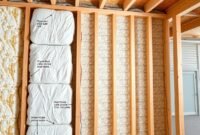How to Insulate Concrete Floor from Cold?
You may consider insulating a concrete floor to keep your damp basement from the cold, a key step in home improvement. Adding insulation, such as spray or rigid foam, can significantly enhance energy efficiency and prevent issues like mold and mildew.
You might be exploring solutions for cold concrete floors or even the best insulation options for a concrete floor.
Did you know that concrete floor is porous?
Yes, you heard it right. Concrete floor on your basement is porous and makes the moisture from the ground flows easily through the board.
Therefore, the moisture over the concrete will increase, potentially damaging the flooring materials. If your basement is set to be a vehicle storage, the moisture will affect it too.
Installing floor insulation, particularly over an uninsulated concrete slab, will significantly reduce heat loss and save on energy bills. Adding a thick rigid foam insulation layer creates a barrier that prevents heat from sinking into the soil beneath the concrete. This not only conserves energy but also protects items stored in your basement.

This insulation method, including spray foam insulation, would also be good for those who have been considering upgrading a garage to a living space or even a bedroom.
It’s important to consider the pros and cons of different types of insulation and how they can impact energy loss and indoor comfort. But the real question is, Is it possible to do without help?
Read also: How to Insulate Windows to Keep Heat Out?
Here, we have explained the essential guide on insulating a concrete floor from cold, including steps for adding insulation effectively. As you read on, consider using a stud finder to locate the ideal placement for insulation and how to feel resistance when installing, ensuring a snug fit.
Preparation
- Make a judge on the condition of your concrete floor.
- Next, you need to detect which floor comes with moisture issues.
- Remember to measure the level carefully and ensure smoothness.
- Calculate the distances between the boar and the ceiling.
Quick tip:
We suggest you leave about 7 feet, 6 inches level. That way, you can estimate the increases that will take up to 2 inches.
So, have you set all the things up? We suggest you to double-check the tools and other materials to prevent you from going back and forth to the local store during the installation.
Once you’re done with the preparations, you’re ready to hang on to the installation. These steps could either be a one-person standing to do the whole process or with a hand of help. We bet 2 people will be ideal to create a fair and solid insulation.
The Installation
To insulate a concrete floor, begin by cleaning the concrete slab’s surface. This step is crucial for ensuring that the vapor barrier, typically a 6-mil polyethylene sheeting, adheres properly.
A clean surface is essential for effectively applying insulation materials, such as spray or rigid foam, to prevent cold air from seeping through. This barrier is essential to prevent moisture from seeping through the porous concrete.
- Clean the surface before starting the insulation installation to achieve even layers.
- Lay a thin layer of asphalt primer to bond the asphalt cement firmly.
- Follow the label directions and allow it to dry thoroughly.
- Lay out the board on each edge side by side in one direction.
- Put sleepers at the end of the board. You need to nail them to ensure they stick to each other.
- When you’re finished nailing the sleepers, you can place 1 ½ -inch of rigid foam in between the strips should be about 12 ½ inches.
- Last but not least, put ¾ inch plywood board over the sleepers.
- Then, you may want to nail them every 6 inches apart. Make sure the sleeper meets every 12 inches of under-panel centers.
- Top off the finished flooring with any insulation materials you prefer.
Conclusion
To conclude, insulating your concrete floor is a good idea to keep the moisture and prevent heat loss. The installation is easy to follow and can be done in one sitting. But, we still recommend you to provide a help of hand to make the installation process go smoothly.
Once you’re done insulating your concrete floor, you will feel a constant comfort level without splurging your money on energy bills. Not to forget, we suggest you remain on the product’s instructions because each product has different materials and guidance to perform at its best.
Remember that sizing is important when insulating a concrete floor to prevent bad performance. Since the floor on your basement is fairly porous, any leakage sites will migrate the moisture and affect the barrier.
If you’re still confused, we advise you to do more digging on how to insulate concrete floor from cold. Watching a YouTube video tutorial might be helpful as well. All in all, we hope you find this article beneficial for you.


